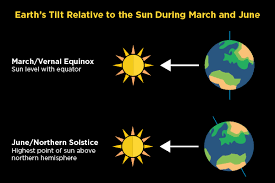Equinoxes and solstices
A year on Earth can be split into four as we complete our orbit of the Sun. Each of these are marked by an equinox or solstice.
What are the solstices and equinoxes?
The Earth’s axis is tilted by 23.4 degrees and so the plane of the Earth’s equator is tilted with respect to the plane of the Earth’s orbit around the Sun – sometimes referred to as the ecliptic.
This means that during the Northern Hemisphere summer, the Sun illuminates the Northern Hemisphere more than the Southern Hemisphere. During this time we receive more hours of sunlight and the longest day is known as the summer solstice. During the winter, the Sun illuminates the Southern Hemisphere more than the Northern Hemisphere because the North Pole is tilted away from the Sun. During this time we receive fewer hours of sunlight and the shortest day (and longest night) is known as the winter solstice.
But at two points in the year the Sun will illuminate the Northern and Southern Hemispheres equally – these are known as the equinoxes: the autumnal equinox in October and the vernal equinox in March. It’s the moment in which the plane of Earth's equator passes through the center of the Sun's disk or the moment that the Sun passes the celestial equator from the Northern to the Southern Hemisphere or vice versa. On these dates, there are approximately equal hours of daylight and darkness.
The ecliptic: the plane in which the Earth and most of the other planets orbit around the Sun over a year.
The celestial equator: an imaginary projection of the Earth's equator onto the sky.
What is the vernal (or Spring) equinox?
The vernal equinox occurs in March, and in the Northern Hemisphere, this date marks the end of Winter and beginning of Spring when the days will start getting longer and the nights shorter.
In 2018 it will occur on 20 March at 4.15pm

Source: https://www.rmg.co.uk/discover/explore/equinoxes-and-solstices
Not indicating that the content you copy/paste is not your original work could be seen as plagiarism.
Some tips to share content and add value:
Repeated plagiarized posts are considered spam. Spam is discouraged by the community, and may result in action from the cheetah bot.
Creative Commons: If you are posting content under a Creative Commons license, please attribute and link according to the specific license. If you are posting content under CC0 or Public Domain please consider noting that at the end of your post.
If you are actually the original author, please do reply to let us know!
Thank You!
The world 'solstice' comes from the Latin solstitium meaning 'Sun stands still' because the apparent movement of the Sun's path north or south stops before changing direction.
source: https://www.rmg.co.uk/